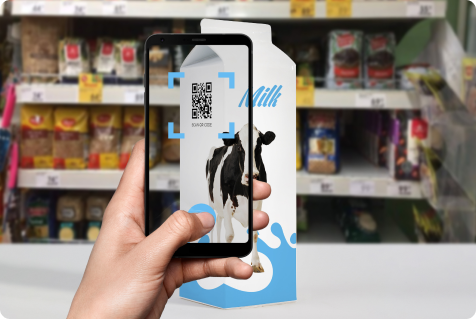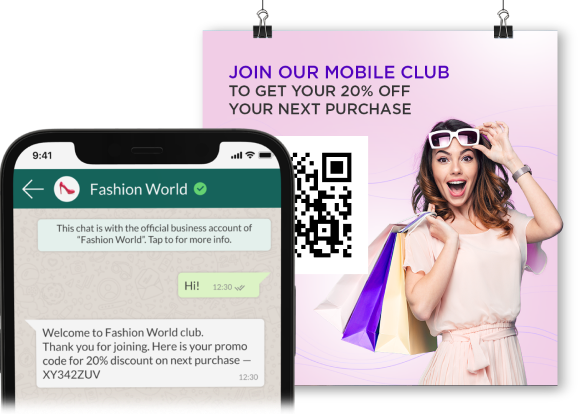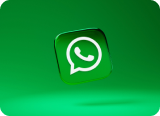The Retailer’s Quick Guide to Customer Acquisition Using Powerful Communication Tools
The retail landscape has changed irrevocably. For the modern retailer, it’s no longer simply about selling a product. It’s more about creating standout experiences for today’s discerning shoppers, who have an abundance of choice and little patience for businesses that are slow to respond to their needs. Thanks to new disruptive technologies, shoppers now rely on multiple digital channels to browse products, read reviews, and make purchases, and trust brands that anticipate their needs and support them throughout their journeys across channels. And this relationship doesn’t stop at purchase — shoppers expect brands to remember and value them as individuals. A single misstep can turn them away, ruining years of hard-earned reputation for brands.
Retailers must contend with this new reality and quickly evolve to be a part of their customers’ online journeys if they are to stay competitive. More so because of the pandemic which has accelerate the inevitable move to online.
Some Insights on Today’s Hyper-Connected Shoppers
| 87%shoppers prefer to look up a product online before making a purchase1 | > 90%text messages are opened by customers, a significantly higher open rate compared to email2 | 40%customers are willing to switch brands if they have a bad customer experience3 | >175Mpeople message a WhatsApp Business Account daily4 |
*Sources: 1 — SalesForce, 2 — Campaign Monitor, 3 — Kearney, 4 — WhatsApp
Expand Your Customer Base Through Offline and Online Channels
There’s one thing in common between all successful retailers today — they’re all customer-focused. Rather than chasing a one-time sale, they are focusing on ways to draw shoppers toward their brand — to instill a sense of fondness and loyalty that will result in long-term relationships, brand advocacy, and ultimately sales lift. Success, for them, hinges on growing and retaining their customer base in a way that feels organic. And they are leveraging both offline and online channels to achieve this.
Leverage Offline Channels to Improve Your Brand’s Reach
Despite the boom in digital retail, the value of offline channels in growing your customer database cannot be discounted. Physical stores are now doubling up as spaces from which retailers drive online micro-conversions from offline traffic which might be completely lost otherwise. Here are a few ways in which retailers can successfully grow their online customer database by leveraging offline channels:
Put the Humble QR Code to New Uses
QR codes are seeing a revival of sorts. Many retail brands are now creating in-store signages displaying QR codes or other ‘Chat With Us’ icons that are helping shoppers reach out to the company directly for detailed product info — be it about available sizes, colors, or manufacturing details. Some brands are even setting up giant screens featuring their products, where each product has a unique QR code. When interested buyers scan the code, they are directly led to the company’s Facebook, WhatsApp, or in-app chat portals for real-time guidance on products and even making payments. In the process, the customer gets added to the brand’s database for retargeting.

Redefine Customer Interactions With Smart Packaging
Retailers have always shared their customer support numbers on their product packages. Taking things further, progressive retailers have now started adding NFC tags, QR codes, or other graphic markers to their packaging that smartphones can easily decipher. Customers can simply point their phone cameras at the code to be redirected to the retailer’s WhatsApp or other chat portals to get their issues resolved. These interactions not just increase trust and convenience for customers, but also help retailers opt-in these customers to continue communication on those channels.
Connect With Event Attendees on WhatsApp
Retailers — whether into footwear, fashion, or beauty — routinely conduct product launches, trade shows, or even marathons to create brand awareness. Many forward-looking retailers are now requesting participants to register for such events via WhatsApp. This helps to ensure WABA opt-ins, drives greater participation as registration is quick and convenient, and helps brands engage with customers directly even long after the event is over.
Make Loyalty Programs More Accessible for Customers
From beauty and apparel brands to global coffee giants, all retailers rely on loyalty programs that incentivize customers with discounted products to drive long-term engagement and sales. Increasingly, retailers are running their loyalty programs entirely on their WhatsApp Business Accounts — customers can track their reward points, look up options to redeem them, and receive virtual coupons, all on WhatsApp. All such programs are tagged to the user’s phone number, and two-factor authentication is carried out on WhatsApp whenever the customer uses loyalty program benefits, ensuring safety.


Drive Engagement With Promo Campaigns
Retailers have always relied on promo campaigns to draw in shoppers. Tech-savvy players are now upping the ante by encouraging customers to sign up for such campaigns digitally. Customers that make a purchase in-store get automatically registered online, while others do so by verifying their phone numbers. Post registration, participants are invited to “like” posts, leave reviews, or even post pictures of themselves using the brand’s products on their Facebook or WhatsApp messengers. The winner gets to take home freebies. Needless to say, these campaigns have helped many a retailer see their customer base explode online.

Use Online Channels to Build a Strong Customer Base
Customers across the retail spectrum have been enthusiastically turning to online shopping for a while — the pandemic has simply accelerated its pace. On cue, many traditional brick-and-mortar retailers — supermarket chains, fashion & beauty brands, furniture behemoths, etc. — have moved fast to create an online presence. But top-flight brands have also realized that simply showing up is not enough — to stand out in a sea of noise, they must proactively reach out to customers and create two-way conversations. Doing this will not just help them increase their reach, but will help to optimize conversion rates. Here’s how some retailers are successfully achieving this:
Increase Traction With Conversational Ads
Most brand discovery today happens on Google, Facebook, and Instagram. These platforms, with their visually rich and engaging ads, greatly pique a shopper’s interest and even influence their purchase decisions. Facebook and Instagram ads often come with a clickable “WhatsApp Us” message that can help customers initiate conversations with brands on WhatsApp. Similarly, Google Ad Lingo helps retailers post conversational display ads with CTA buttons that redirect customers to the live chat, where conversations can start instantly. This creates a sense of trust between shoppers and the brand and fosters brand loyalty.

Deploy Website and In-App Live Chat for Real-Time Customer Support
Today’s shoppers are an impatient lot — they demand instant query resolution and prefer to message businesses rather than call or email them. Therefore, savvy retailers make sure to have a live chat option not just on their websites but also on their apps — this helps them provide real-time query resolution, whether their customers are just discovering a product or in the middle of a purchase. Live chats ensure that customers do not lose momentum when they are mulling over a purchase decision.
Leverage Push Notifications to Re-Engage Passive Users
Retail success hinges not only on lead generation but on proper nurturing of each relationship. Customers who may have downloaded a brand’s app at some point may not no longer be active on it or even open it. PUSH notifications are a great way for retailers to gently nudge their customers to check out their apps once again. Retailers can send out prompts based on their customers’ interests and purchases, and add images, videos, audios, emojis and gifs to make their messages appealing. This increases brand-customer interactions as well.
Selecting the Right Platform for Customer Acquisition — And What You Need to Watch Out For
While most traditional retailers do realize the need to reach out to their audiences digitally, they still lag when it comes to understanding which
technologies will give them a real edge. They rightly identify WABA / Live Chat (Web & Mobile) and Facebook Messenger to be the most popular
channels, but need some handholding when it comes to selecting the right communication solution provider that will connect them seamlessly
with millions of customers. And it’s a crucial choice that will largely determine how well their efforts are ultimately rewarded. A few things to be
mindful of while picking the right partner are:
Is my solution provider officially authorized to offer such services?
Make sure your provider is authorized to do so. That way, you can rest assured your connections are private, secure, end-to-end encrypted, and GDPR compliant. Also, you never need to worry about getting your account banned and losing all communication data.
Will the platform integrate with my existing business tools?
Make sure the platform you choose easily integrates with your existing CRM systems such as POS, e-commerce platforms, ordering systems, logistics, delivery systems, and existing bots. This has multiple benefits — it will help you augment your existing systems, minimize costs of upgrading infrastructure, gather new customer data and integrate it with existing data, and enable diverse teams such as sales, marketing and customer care to work together to create outstanding customer experiences.
Does it have communication automation capabilities to gauge channel preferences of my customers and engage with them accordingly?
Communication channel preferences of customers widely vary depending on the customer demographics as well as the kind of interactions they are seeking — some may prefer live chat to resolve queries and email to receive order invoice. Others may prefer WhatsApp for all interactions. Brands often fail to reach out to customers on their favorite channels, leading to low conversions and dissatisfaction.
The right technology partner can help you personalize each interaction at scale by leveraging omnichannel communication automation. Such an advanced automation tool helps you to put in place channel cascading rules based on your customer’s choice.
Is my omnichannel presence managed by a single, easy-to-use interface?
Make sure you have a unified platform that collates data from multiple channels to give you a single, all-round view of the customer. See that your communication hub has a single queue for multiple chat conversations, which will help you avoid the hassles of flicking through multiple windows. Also, it should offer customer insights, KPI dashboards, and chat controls in a single window interface to provide a truly unified experience — not just for customers but also for employees who are working to provide that experience.
edna is a leading digital communication solutions provider that is revolutionizing the way organizations connect and converse with consumers. For more than 15 years, we have been helping companies to use advanced communication technologies to orchestrate streamlined, programmatic omnichannel communications over all major social messengers, live web and in-app mobile chat, PUSH messaging and SMS. edna is an official service provider for WhatsApp Business, Apple Business Chat, and Viber for Business. We work with 550+ enterprise clients that include leading organizations in Retail, FMCG, Banking, Insurance, Air Travel, Telecom, Hospitality and Healthcare and process 4 Billion+ messages every month. Learn more about our offerings at edna.io



